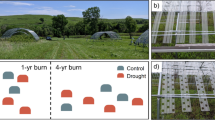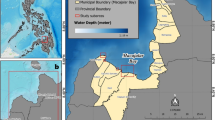Abstract
A fire occurred (0.59 ha) in an alpine fellfield (2600 m a.s.l.) on Mount Shirouma, central Japan, on 9 May 2009 before the start of the growing season. Herbaceous plants and dwarf pine Pinus pumila dominated the site. Plots were established in burned and unburned herb vegetation and P. pumila scrub just after the fire to monitor vegetation recovery. This study reports the short-term monitoring results 3 months after the fire. Burned herb vegetation mostly recovered by late August 2009. However, burned P. pumila did not recover, and other alpine plants were scarce in burned P. pumila scrub. The observed number of species in herb vegetation was 15–20 m−2 whereas it was only 1–6 m−2 in P. pumila scrub. The total cover of plants was 111–129% for burned herb vegetation but was only 8–31% for burned P. pumila scrub. Although the species composition in P. pumila scrub distinctly differed between burned and unburned plots, in herb vegetation it was similar between them. Therefore, P. pumila scrub was greatly damaged by the fire, whereas herb vegetation was not damaged. Rapid recovery of herbaceous plants was because winter buds in the soil were not damaged by the fire, but winter buds on shoots of P. pumila were burned. Therefore, the difference in winter bud location (above or belowground) may have resulted in the difference in damage between herbaceous plants and P. pumila.

Similar content being viewed by others

References
Beck E, Scheibe R, Schulze ED (1986) Recovery from fire: Observations in the alpine vegetation of western Mt. Kilimanjaro (Tanzania). Phytocoenologia 14:55–77
Bell KL, Bliss LC (1979) Autecology of Kobresia bellardii: why winter snow accumulation limits local distribution. Ecol Monogr 49:377–402
Brown CS, Mark AF, Kershaw GP, Dickinson KJ (2006) Secondary succession 24 years after disturbance of a New Zealand high-alpine cushionfield. Arct Antarc Alp Res 38:325–334
Callaway RM, Brooker RW, Choler P, Kikvidze Z, Lortiek CJ, Michalet R, Paolini L, Pugnaireq FI, Newingham B, Aschehoug ET, Armas C, Kikodze D, Cook BJ (2002) Positive interactions among alpine plants increase with stress. Nature 417:844–848
Choler P, Michalet R, Callaway RM (2001) Facilitation and competition on gradients in alpine plant communities. Ecology 82:3295–3308
Douglas GW, Ballard TM (1971) Effects of fire on alpine plant communities in the north Cascades, Washington. Ecology 52:1058–1064
Editorial Board of Flora of Nagano Prefecture (1997) Flora of Nagano Prefecture. Shinano Mainichi Shinbunsha, Nagano (in Japanese)
Hadley JL, Smith WK (1983) Influence of wind exposure on needle desiccation and mortality for timberline conifers in Wyoming, USA. Arct Alp Res 15:127–135
Hayashida M (1994) Role of nutcrackers on seed dispersal and establishment of Pinus pumila and P. pentaphylla. In: Schmidt WC, Holtmeier FK (eds) Subalpine stone pines and their environment: the status of our knowledge, General Technical Report INT-GTR-309. USDA Forest Service, Ogden, pp 159–162
Japan Meteorological Agency (2009) Search for past climatic data. Available from http://www.data.jma.go.jp/obd/stats/etrn/index.php. Accessed 18 November 2009 (in Japanese)
Kanai T, Masuzawa T (1993) Seasonal changes in reserve substances of herbaceous perennials in the alpine zone of Mt. Fuji. Proc NIPR Symp Polar Biol 6:126–132
Kariya Y, Harayama S, Ikeda A, Suzuki K (2009) Effects of forest fire on geomorphology and geology on Mt. Shirouma. In: Reports of protection and management of alpine plants on Mt. Shirouma. Chushin Forestry Office, Forestry Agency, and Institute of Mountain Science, Shinshu University, pp 37–54 (in Japanese)
Kibe T, Masuzawa T (1992) Seasonal changes in the amount of carbohydrates and photosynthetic activity of Pinus pumila Regel on alpine in central Japan. Proc NIPR symp Polar Biol 5:118–124
Kikuchi T (1986) Effects of forest fire on plant communities. Iden 40:6–9 (in Japanese)
Kira T (1948) On the altitudinal arrangement of climatic zones in Japan. Kanti-Nogaku 2:143–173 (in Japanese)
Kirkpatrick JB, Dickinson KJM (1984) The impact of fire on Tasmanian alpine vegetation and soils. Aust J Bot 32:613–629
Kirkpatrick JB, Bridle KL, Wild AS (2002) Succession after fire in alpine vegetation on Mount Wellington, Tasmania. Aust J Bot 50:145–154
Körner C (1999) Alpine plant life. Springer, Berlin
Mackay JR (1995) Active layer changes (1968 to 1993) following the forest-tundra fire near Inuvik, N.W.T., Canada. Arc Alp Res 27:323–336
Matsumoto Y, Ogata T, Uchikawa H (2006) Areal classification based on the number of trekkers in the Ushiro-Tateyama Range, Northern Japanese Alps. J Geogr 115:221–235 (in Japanese)
Moony HA, Billings WD (1960) The annual carbohydrate cycle of alpine plants as related to growth. Am J Bot 47:594–598
Nakashizuka T (1985) Diffused light conditions in canopy gaps in a beech (Fagus crenata Blume) forest. Oecologia 66:472–474
Natori Y, Matsuda Y (1966) The age and the thickening growth of Pinus pumila Regel on Mt. Norikura in Honshu, Japan. Jpn J Ecol 16:247–251 (in Japanese)
Phoenix GK, Gwynn-Jones D, Lee JA, Callaghan TV (2000) The impacts of UV-B radiation on the regeneration of a sub-arctic heath community. Plant Ecol 146:67–75
Putz FE (1983) Treefall pits and mounds, buried seeds, and the importance of soil disturbance to pioneer trees on Barro Colorado Island, Panama. Ecology 64:1069–1074
Racine C, Jandt R, Meyers C, Dannis J (2004) Tundra fire and vegetation change along a hillslope on the Seward Peninsula, Alaska, USA. Arct Antarc Alp Res 36:1–10
Reader RJ, Mallik AU, Hobbs RJ, Gimingham CH (1983) Shoot regeneration after fire or freezing temperatures and its relation to plant life-form for some heathland species. Vegetatio 55:181–189
Romme WH, Despain DG (1989) The Yellowstone fires. Sci Am 261:21–29
Saito S (1983a) Catching of Japanese stone pine seeds by Nutcrackers at the Shiretoko Peninsula, Hokkaido. Tori 32:13–20 (in Japanese)
Saito S (1983b) On relations of the caching by animals on the seed germination of Japanese stone pine, Pinus pumila Regel. Bull Shiretoko Museum 5:23–40 (in Japanese)
Sakai A (1960) The frost-hardening process of woody plant VII. Seasonal variations in sugars (2). Low Temperature Sci, Hokkaido Univ B18:1–14 (in Japanese)
Sano M, Ujihara T (1983) The ecological studies of alpine plants III. Influence of human activity on the alpine vegetation of Mt. Kisokoma. J Fac Agr, Shinshu Univ 20:83–95 (in Japanese)
Shibata O, Nishida T (1993) Seasonal changes in sugar and starch content of the alpine snowbed plants, Primula cuneifolia ssp. hakusanensis and Fauria crista-galli, in Japan. Arct Alp Res 25:207–210
Takahashi K (1986) Relationship between forests and fire. Iden 40:22–26 (in Japanese)
Takahashi M, Kikuchi T (1986) The heat effect on seed germination of some species in the initial stage of a post-fire vegetation. Ecol Rev 21:11–14
Taylor AH (2000) Fire regimes and forest changes in mid and upper montane forests of the southern Cascades, Lassen Volcanic National Park, California, USA. J Biogeogr 27:87–104
Taylor AH, Qin Z (1993) Structure and dynamics of bamboos in the Wolong Natural Researve, China. Am J Bot 80:375–384
Tolsma AD, Read SM, Tolhrst KG (2007) Roots of Australian alpine plant species contain high levels of stored carbohydrates independent of post-fire regeneration strategy. Aust J Bot 55:771–779
Tsuchida K (1999) Restoration of alpine vegetation in Mt. Shirouma, the Northern Japanese Alps. Jpn J Ecol 49:321–328 (in Japanese)
Tsuda S (1995) Process of vegetation recovery after fire. Jpn J Ecol 45:145–159 (in Japanese)
Vavrek MC, Fetcher N, McGraw JB, Shaver GR, Chapin FS III, Bovard B (1999) Recovery of productivity and species diversity in tussock tundra following disturbance. Arct Antarc Alp Res 31:254–258
Veblen TT, Kitzberger T, Donnegan J (2000) Climatic and human influences on fire regimes in ponderosa pine forests in the Colorado Front Range. Ecol Appl 10:1178–1195
Williams RJ, Wahren CH, Tolsma AD, Sanecki GM, Papst WA, Myers BA, McDougall KL, Heinze DA, Green K (2008) Large fires in Australian alpine landscapes: their part in the historical fire regime and their impacts on alpine biodiversity. Int J Wildl Fire 17:793–808
Worboys GL (2003) A brief report on the 2003 Australian Alps bushfires. Mount Res Develop 23:294–295
Yarie J (1981) Forest fire cycles and life tables: a case study from interior Alaska. Can J For Res 11:554–562
Yoshida S, Sakai A (1967) The frost-hardening process of woody plant XII. Relation between frost resistance and various substances in stem bark of black locust trees. Low Temperature Sci, Hokkaido Univ B25:29–44 (in Japanese)
Zachhuber K, Larcher W (1978) Energy contents of different alpine species of Saxifraga and Primula depending on their altitudinal distribution. Photosynthetica 12:436–439
Zackrisson O (1977) Influence of forest fires on the north Swedish boreal forest. Oikos 29:22–32
Acknowledgments
I thank the staff of the Chushin Forestry Office for their kind support. This study was done as a part of commission researches from Chushin Forestry Office.
Author information
Authors and Affiliations
Corresponding author
Electronic supplementary material
Below is the link to the electronic supplementary material.
11355_2010_134_MOESM1_ESM.pdf
Photo S1. Overview of a burned site on Mt. Shirouma, central Japan. Broken red line indicates the burned site (0.59 ha). Dark green and light green indicate Pinus pumila (a, b) and herb vegetation (b), respectively. Outer brown area of P. pumila patches was burned (PDF 1054 kb)
11355_2010_134_MOESM2_ESM.pdf
Photo S2. Burned Pinus pumila scrub (a), newly emerged shoots in burned herb vegetation (b), and vegetation recovery of herbs (c, d) on Mt. Shirouma, central Japan. Burned P. pumila did not recover (c, d). Photos were taken on 1 June 2009 (a, b) and 25 August 2009 (c, d) (PDF 1432 kb)
Rights and permissions
About this article
Cite this article
Takahashi, K. Damage of alpine vegetation by the 2009 fire on Mt. Shirouma, central Japan: comparison between herbaceous vegetation and Pinus pumila scrub. Landscape Ecol Eng 8, 123–128 (2012). https://doi.org/10.1007/s11355-010-0134-z
Received:
Revised:
Accepted:
Published:
Issue Date:
DOI: https://doi.org/10.1007/s11355-010-0134-z



